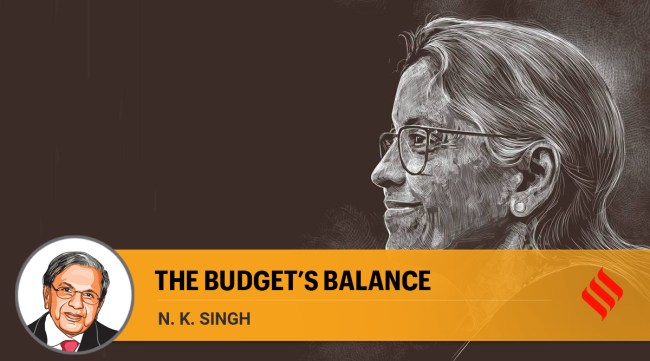Opinion This year’s budget represents continuity with trust
NK Singh writes: It is a commendable balancing act, seeking symmetry between contradictory pulls and pressures
 Finance Minister Nirmala Sitharaman. (Illustration: Shyam Kumar)
Finance Minister Nirmala Sitharaman. (Illustration: Shyam Kumar) Each Budget must respond to the contemporary challenges and be sensitive to the mood of the times. In this sense, this year is somewhat unique.
The raging pandemic imposed atypical expenditure burdens. Uncertainties on the path of the pandemic loom large. This circumscribes policy prognosis. The elections in five important states, including Uttar Pradesh, loom large. Its outcome would determine the political course for policymakers vis a vis far-reaching economic and structural reforms. Domain experts have concluded that monetary policy has run out of steam. The efficacy of any policy of forbearance and extending guarantees or moratoriums is no substitute for fiscal action. Fiscal stimulus is stressed for job creation and relief to the MSME sector and the informal sector.
In this context, this budget is a commendable balancing act. It is seeking symmetry between contradictory pulls and pressures. It represents continuity with trust.
To begin with, Finance Minister Nirmala Sitharaman was truthful that this was no time for tax reprieves. The fact that she has not resorted to tax increases normally expected during a pandemic through enhanced health cess or a pandemic tax is no mean achievement. Continuity in tax policies is central and obviating unpleasant surprises reinforces investor confidence.
Second, the continued emphasis on capital expenditure (capex), which decisively alters outcomes of public outlays is a long awaited expenditure reform. Capex has gone up by 26 per cent, from Rs 4.39 trillion in FY21 to Rs 5.54 trillion in FY22. Job creation will be the direct outcome of enhanced capex and altering of employment patterns in seeking more gainful employment and asset creation, such as through the National Highways Development Programme and the National Infrastructure, giving an impetus to Gati Shakti.
Third, this focus on productive capex comes ahead of elections in five states. The government could have been distracted by more direct monetary support to influence the electoral psyche. The decision to stay away from a populist budget is consistent with the PM’s objective to enhance our long term competitive efficiency supporting growth objectives and a new export thrust.
A fiscal consolidation of half percentage point for the following year is significant. This is consistent with the objectives of a 4.5 per cent fiscal deficit at the end of 2024-25. No doubt, this is somewhat higher than the stipulated 3 per cent in the FRBM Act and a little misaligned with the 4 per cent suggested by the Finance Commission. However, this exercise, commenced last year and continued this year in taking on all extra budgetary borrowings, contingent liabilities and extra budgetary resources, reinforces the credibility of our accounting process.
One of the outstanding achievements is the somewhat unexpected revenue buoyancy. Painful but sustained efforts in improving GST outcomes as well as on direct taxes will result in tax to GDP of around 10.7 per cent over the next year. This is a significant gain considering that tax to GDP has for long languished far below its potential. The GST Council must now engage in more decisive action in broad banding, inverted duty structure and including excluded items as well as improving all-round compliance. We are, by international reckoning, losing about 4 percentage points of GDP in our overall revenue realisation. A coherent plan on sustaining our current revenue buoyancy would be keenly watched.
This budget must be read in conjunction with the statements of fiscal policy as required under the FRBM Act, which includes statements of the macroeconomic framework and medium term fiscal policy cum strategy. According to the IMF’s Fiscal Monitor report published in late October 2021, countries which have a fiscal rule must focus more clearly on cyclically adjusted fiscal balance. On debt, the report suggests even a longer timeframe of aligning emerging markets’ original debt targets anywhere beyond 10 years. The current debt to GDP of 90.6 per cent is somewhat above comfort levels. Given that the debt stock is high, spectacular changes cannot be expected in one year. However, the direction is a positive one.
For the agriculture sector, the setback on farm reforms could have shelved further action. Yet the budget strategy includes improving the farm incomes and long term productivity of agriculture including crop diversification. The digitisation of land records is important for market based economies to be benefited by the agriculture sector.
On education, the need for bridging the digital divide has been echoed. The setting up of 200 TV stations as well as digital universities are important steps. On technology, the spectrum of 5G mentioned in the budget along with Artificial Intelligence and machine learning will enhance the reach of the technology revolution.
The need for more integrated urban planning in making the urban sector a true engine of growth has been echoed in the budget with the recommendation of the formation of a high-level committee. Attention has been given to Gati Shakti being replicated for the Northeast states. The encouragement of the states for enhancing capex by supporting capital outlays of Rs 1 lakh crore would make a significant difference in their efforts to strengthen infrastructure development through the state highways, Pradhan Mantri Gram Sadak Yojana, and other related logistics. Equally, acting on the recommendation of the Fifteenth Finance Commissions, the acceptance of a borrowing limit of 4 per cent than the 3 per cent in the state FRBM with 0.5 per cent earmarked for power sector reforms will improve the states’ overall economic efficiencies.
In terms of the road ahead, there are a few areas where we can reinforce our actions. First, public outlay on health has remained somewhat static. Hopefully this would be somewhat rectified.
Second, the delay in the programme of the BharatNet Scheme for providing high-speed digital connectivity to all villages. Third, on the energy transition and the outcomes of COP26 and reiterating the commitments of PM Modi’s Panchamrit. The green bonds will augment resources but each of the ingredients of the Panchamrit deserve closer attention including a coal transition map. The net zero target imposes obligations for a non-disruptive transition to renewable green technology. Fourth, innovative steps to garner private investment through guarantees and regulatory changes are important. Fifth, the creation of credible fiscal institutions has eluded action. Finally, we must be wary of uncertainties related to geopolitics, the behaviour of crude oil prices, the ongoing pandemic and the global recovery process.
The finance minister, even on Budget Day, is not a Gogia Pasha who pulls rabbits from a hat. The prime minister has commended the budget. It is indeed an Amrit Kal Budget.
This column first appeared in the print edition on February 3, 2022 under the title ‘The budget’s balance’. The writer is chairman, 15th Finance Commission







